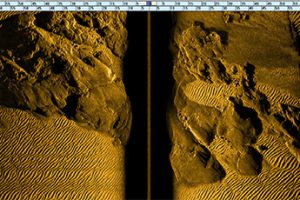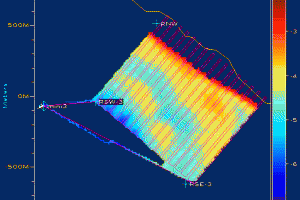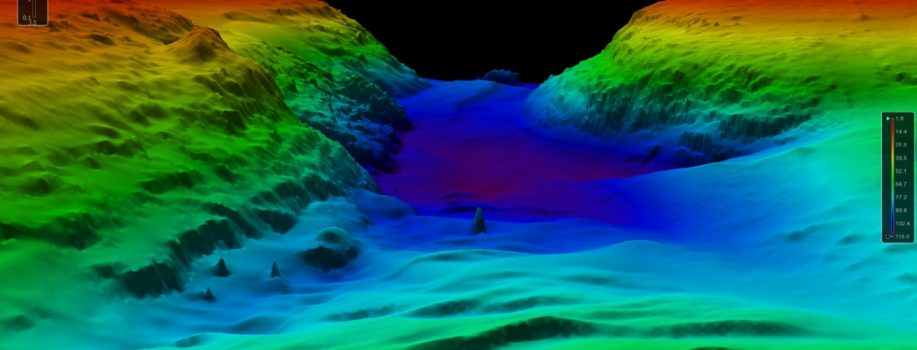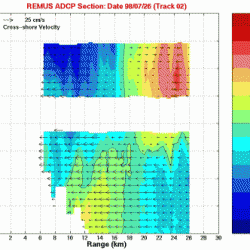A CLASS OF ITS OWN
Developed as a two man-portable, yet operationally flexible AUV (Autonomous Underwater Vehicle), the REMUS 100 system is rated to 100 meters and has become the industry leader AUV since its debut in 1995. The REMUS 100 system has demonstrated capabilities, which are pertinent to marine research, hydrographic, oceanographic offshore/energy, and military applications. It is ideal for coastal hydrographic survey and target localisation missions while requiring minimal infrastructure to support and operate.
A UNIQUE VEHICLE FOR OCEAN TECH
The Ocean Tech REMUS 100 has been specially engineered and upgraded. Our vehicle is the most advanced marine research REMUS 100 on the planet and is modular in design. The vehicle comprises multiple sensors and imaging systems that are field swappable. This modular design means our vehicle can be used for an extremely diverse range of oceanographic and marine research missions.

Ocean tech REMUS capabilities
- Water quality assessments
- Hydrographic / Geophysical Surveys
- Ecosystem assessments
- Physical Oceanography
- Environmental Monitoring
- Marine/ Geology Investigation
- Marine Biology
- Fisheries research
- Seabed Mapping
- Fish Stock assessments
- Pipeline servery's
- Cabling surveys
- Wreckage detection
- Geology Seafloor mapping
- Water quality
- Route surveys
- Pre-Post dredging surveys
- Debris & clearance after storms
- Shipwreck hunting & Salvage
- Current profiling & surveys
The UUV 3500 was developed as a side scan sonar with the unique benefit of an advanced bathymetry payload for the growing Autonomous Underwater Vehicles (AUVs). The UUV 3500 product line leverages a powerful - wholly FPGA implemented - multi-channel processing engine. The sonar engine simultaneously optimises two different and concurrent output data streams for photo quality side-scan imagery and high accuracy, co-registered Swath Bathymetry.
With the addition of the swath bathymetry sonar, the Klein system employs advanced interferometric signal processing to produce simultaneous estimates of the seabed topography out to the full swath extent of the sonar, typically 10-12 times the overall altitude of the AUV. The added seabed topographic measurement is post-processed and co-registered with the side scan backscatter imagery to more accurately position seabed targets. Sonar beamforming is done by the Klein system electronics thus allowing for integration with onboard CAD/CAC software.
iXblue C3 IMU w/ NavP Vehicle navigation +
- Inertial navigation for survey grade navigation
- iXblue’s silent true solid state Fiber-Optic Gyroscope technology built-in
- The Kongsberg Maritime NavP aided inertial navigation system built-in
- Precise, reliable acoustic positioning
Wetlabs Triplet ECO Puck
The Triplet is a special-order, three-optical-sensor instrument available in a user-defined configuration. The Triplet addresses the need for multiple simultaneous scattering and fluorescence sensors for autonomous and unattended measurement platforms.
The sensor is primarily used to measure Turbidity & Fluorescence. The sensor is customised at build, capable of: one scattering, two fluorometers; two scattering, one fluorometer; three fluorometer or three scattering measurements. Options include:
- Blue scattering
- Green scattering
- Red scattering
- Chlorophyll fluorescence
- CDOM fluorescence
- Phycoerythrin fluorescence
- Phycocyanin fluorescence
- Rhodamine fluorescence
- Uranine (fluorescein) fluorescence
REMUS 100 video with X4 PARALENZ DIVE CAMERAs
REMUS 100 filming is achieved by using Paralenz dive camera +. The cameras are hydrodynamic and depth rated to 250 meters. This means the vehicle must be restricted to 250 meters max flight depth on filming missions. 4 cameras are available to attach to REMUS., one forward, one back and one filming off each side of the vehicle. The cameras will record for 3+ hours at 1080 - 25fps. This also restricts filming missions to 3 hours.
The Paralenz+ camera has a pressure sensor that is used to automatically control the white balance so it produces honest colour through the depth range It can also display depth and temperature as an overlay in the video, this can be added after the video has been shot using a smartphone/tablet app.
- 250M / 820FT / 26 ATM
- Auto, 3 different fixed WB and DCC (Depth-controlled Color Correction)
- LiPo – 1600 mAh / 3+ hrs recording (1080p – 30 fps) / 2+ hrs recording (4K – 30 fps)
- 8 megapixels
- 4k-30 FPS / 2.7k-60 FPS / 1080p-100 FPS / 720p-200 FPS
- WiFi (app connection), Bluetooth (future accessories) & USB 0.5” OLED
- MOV – H.264 codec
- 64 GB or 128 GB Micro SD-card (Class: U3 or V30) – not included
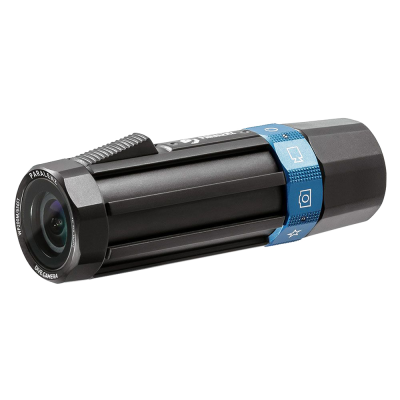
EK-80 Fish Sonar system
This is the first time an EK80 has been adapted and installed on a REMUS 100 AUV. The Simrad EK80 supersedes the popular Simrad EK60, a system that has sold more than 1,100 units for research vessels worldwide and has become an international standard for fish stock assessment. The EK80 provides an advanced tool for scientists investigating marine and freshwater ecosystems.
The system exploits wideband echo sounder technology where backscatter levels from a range of frequencies are processed, providing enhanced target information. The wideband frequency sweep (chirp) in combination with advanced signal processing gives an excellent signal to noise ratio and range resolution. This combination of high resolution and detailed frequency response assists scientists with ecosystem monitoring and stock assessments enabling them to identify species more accurately.
Post-processing software is required to make the most of the EK80 data. Once the data is processed through one of the suitable packages listed below, the EK80 can deliver astonishing information about territories fish stocks.
- Total Biomass
- Schools
- Single target detection and identification
- Seep and plume detection
- Hydrography and bottom type
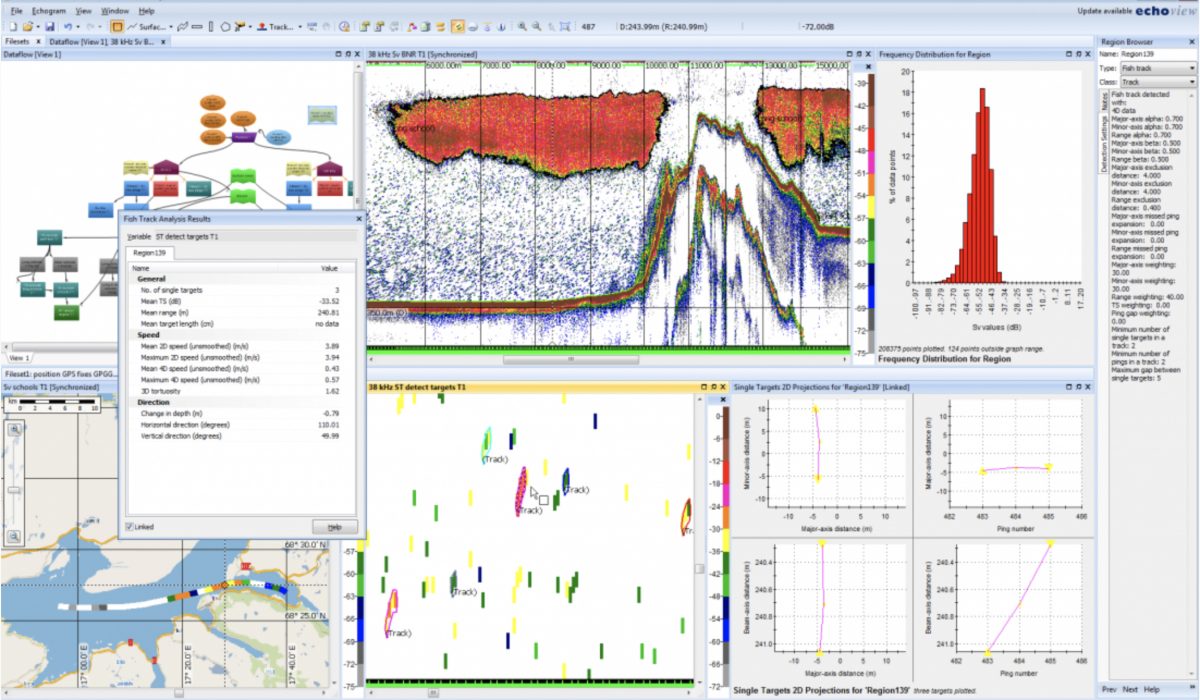
Aanderaa Oxygen Optode sensor.
The Oxygen optode is designed to measure absolute oxygen concentration and % saturation. The optode can be used from streams to the deep sea, from fish farms to wastewater and from polar ice areas to hydrothermal vents. The lifetime-based luminescence quenching principle offers the following benefits:
- Response time <8 sec (63%)
- High accuracy
- Not stirring sensitive (it consumes no oxygen)
- Lower fouling sensitivity
- Measures absolute oxygen concentrations without repeated calibrations
- Better long-term stability
- Hot water monitoring
- Less affected by pressure
- Not sensitive to H2S
- Not freezing sensitive
YSI Conductivity and Temperature Sensor
Temperature
YSI utilises a high-precision thermistor: 2252 ohms at 25ºC (±1%) for temperature measurement. Resistance changes with temperature and the 6-Series sondes convert resistance into ºC, ºF, or K automatically. Best of all, the temperature sensor is calibration-and-maintenance-free.
Specifications:
Range: -5 to 50ºC
Resolution: 0.01ºC
Accuracy: ±0.15ºC
Conductivity
Four pure-nickel electrodes allow the YSI 6560 sensor to determine the conductivity of a sample accurately. Along with conductivity, the YSI 6-Series sonde can calculate specific conductance, salinity, resistivity and total dissolved solids.
Specifications:
Range: 0 to 100 mS/cm
Resolution: 0.001 to 0.1 mS/cm (range
dependent)
Accuracy: ±0.5% of reading plus 0.001 mS/cm
Certifications:
U.S. EPA ETV
